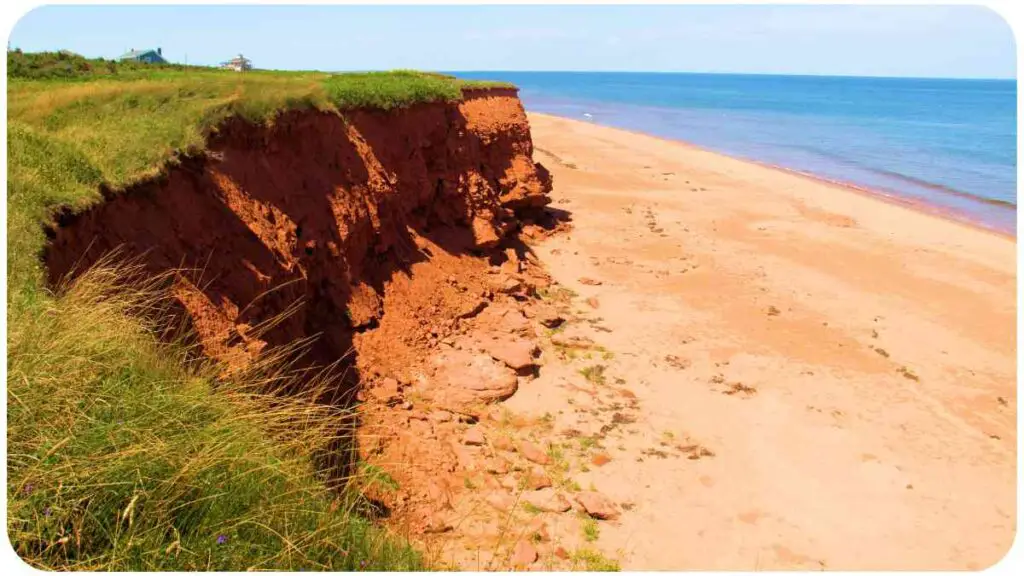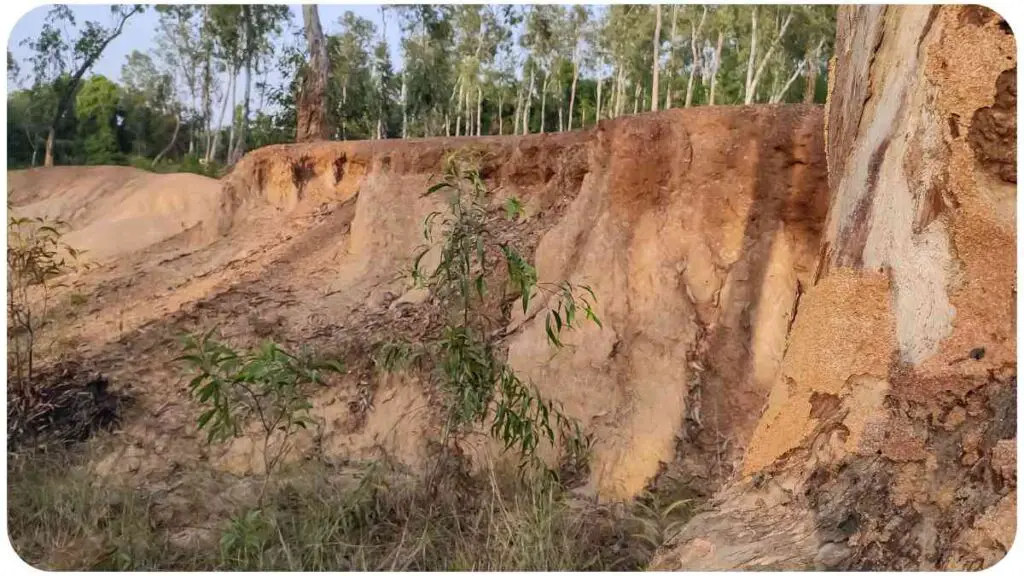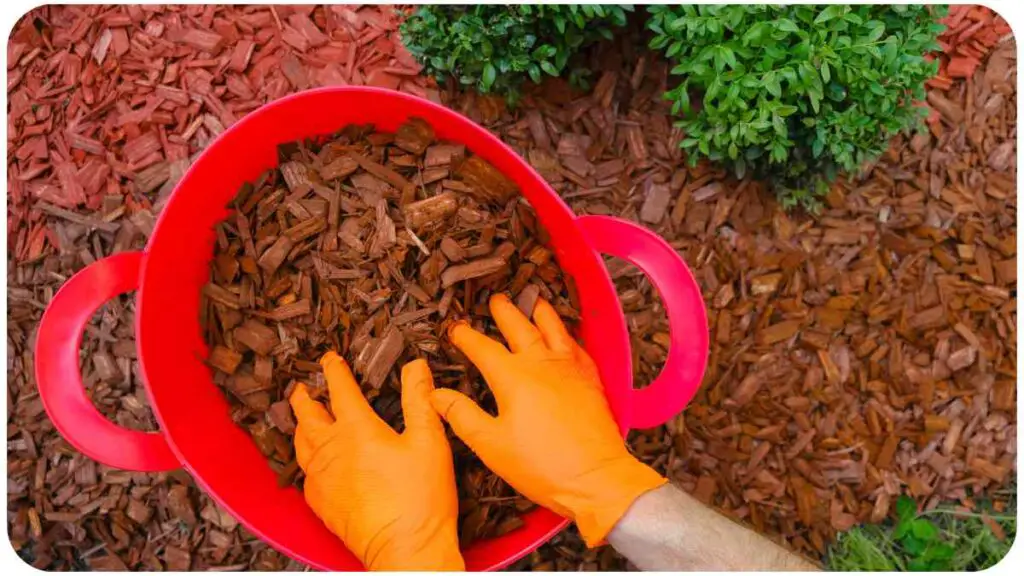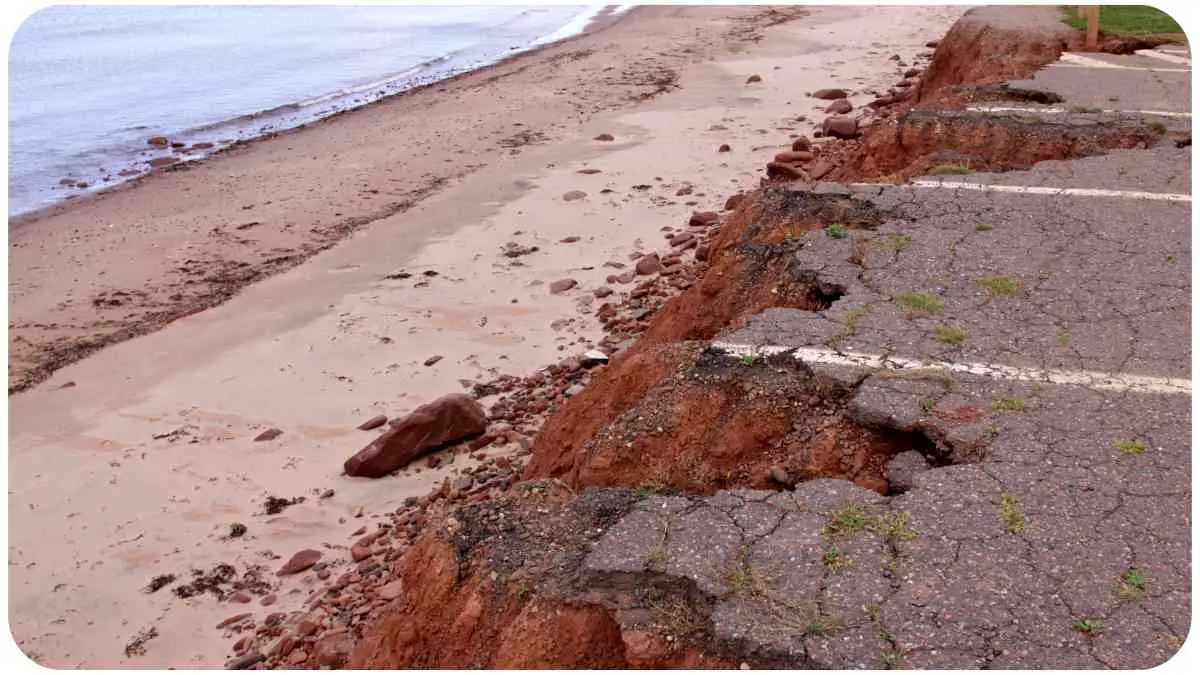Erosion is a persistent nemesis for landscapes, causing a myriad of problems that can disrupt the beauty and functionality of your outdoor spaces. In this comprehensive guide, we will delve into the intricacies of erosion, its impact on landscapes, and effective strategies to combat it.
Whether you’re a homeowner, a landscaper, or a property manager, understanding and addressing erosion is crucial for maintaining a vibrant and healthy environment.
| Takeaway |
|---|
| Effective erosion control requires a multifaceted approach, from understanding causes to implementing hardscape solutions and seeking professional assistance. |
| Proactive planning, strategic implementation, and vigilant maintenance are key to long-term success in preventing soil erosion. |
| Explore budget-friendly options like DIY techniques, recycled mulch, and native plant propagation to manage erosion without breaking the bank. |
| Real-life success stories showcase the impact of various erosion control strategies in residential, commercial, and community landscapes. |
| Regular inspections, seasonal adjustments, and prompt issue resolution are crucial for maintaining the effectiveness of erosion control measures over time. |
2. Understanding Erosion
2.1 What Causes Erosion?
Erosion can be triggered by various factors, including rainfall, wind, and improper land use practices. Understanding these causes is the first step towards effective erosion control.
In the pursuit of a thriving garden, proper drainage is paramount. Discover common issues and effective fixes to ensure your landscape flourishes with vitality.
Table: Causes of Erosion
| Cause | Description |
|---|---|
| Rainfall | Heavy rain can wash away topsoil and nutrients |
| Wind | Wind erosion is common in arid regions |
| Improper Land Use | Construction and deforestation contribute |
2.2 Identifying Erosion Prone Areas

Certain areas are more susceptible to erosion. Learn how to identify these zones to implement targeted erosion control measures.
Table: Erosion-Prone Zones
| Zone | Characteristics |
|---|---|
| Sloped Areas | Increased water runoff |
| Bare Soil | Lack of vegetation exposes soil to erosion |
| Compacted Soil | Reduced permeability enhances erosion risk |
3. The Impact of Erosion on Landscapes
Erosion doesn’t just alter the appearance of your landscape; it can have far-reaching consequences. Let’s explore the various impacts on soil quality, structural integrity, and the broader environment.
3.1 Soil Quality and Nutrient Loss
Erosion strips away the topsoil, which is rich in essential nutrients. This not only hampers plant growth but also affects the overall health of the ecosystem.
Uncover the secrets to maintaining healthy plant growth by addressing soil compaction issues. Learn valuable tips for optimizing soil conditions and nurturing a resilient landscape.
Table: Nutrient Loss Impact
| Impact | Consequence |
|---|---|
| Reduced Fertility | Depletion of essential nutrients in the soil |
| Plant Stagnation | Hindered growth due to nutrient deficiency |
| Water Contamination | Runoff carries pollutants into water bodies |
3.2 Structural Damage
Beyond affecting the soil, erosion can compromise the structural integrity of your landscape. This includes damage to buildings, pathways, and other infrastructure.
Table: Structural Damage
| Type of Damage | Consequence |
|---|---|
| Foundation Erosion | Weakening of building foundations |
| Pathway Instability | Cracks and shifts in walkways and driveways |
| Landscape Distortion | Altered topography and uneven terrain |
3.3 Environmental Consequences
Erosion doesn’t just stay within the confines of your property; it can have broader environmental impacts. Understanding these consequences is vital for responsible landscaping.
Guard your garden against the menace of fungal diseases with insights on identification and treatment. Ensure the longevity of your plants by understanding and managing these common challenges.
Table: Environmental Consequences
| Impact | Consequence |
|---|---|
| Habitat Disruption | Displacement of wildlife due to altered landscapes |
| Water Resource Issues | Increased sedimentation affecting water quality |
| Biodiversity Decline | Loss of plant and animal species in the ecosystem |
4. Assessing Your Landscape for Erosion

To combat erosion effectively, you need to assess your landscape. This involves understanding the soil composition, analyzing topography, and identifying patterns of water flow.
4.1 Soil Composition Testing
Knowing the composition of your soil is crucial for devising appropriate erosion control strategies.
Table: Soil Composition Testing
| Test | Purpose |
|---|---|
| Soil Texture Analysis | Determines soil composition (silt, clay) |
| Nutrient Testing | Identifies nutrient levels in the soil |
| Percolation Rate Test | Measures water absorption by the soil |
4.2 Topography Analysis
The topography of your landscape plays a significant role in erosion. Understanding slopes and high-risk areas is essential for effective planning.
Decode the mysteries behind yellow leaves on your garden plants. This comprehensive solution offers valuable guidance to diagnose and rectify issues affecting your plant’s health.
Table: Topography Analysis
| Factor | Consideration |
|---|---|
| Slope Gradient | Steeper slopes are more prone to erosion |
| Watershed Identification | Identifying natural drainage patterns |
| Low-lying Areas | Potential pooling of water |
4.3 Identifying Water Flow Patterns
Understanding how water moves across your landscape helps in pinpointing potential erosion hotspots.
Table: Water Flow Patterns
| Flow Direction | Mapping water movement helps target areas at risk |
|---|---|
| Concentrated Runoff | Identifying channels prone to erosion |
| Erosion Buffer Zones | Creating vegetated areas to absorb excess water |
5. Proactive Planning: Landscaping Strategies
Now that we’ve assessed the landscape, it’s time to delve into proactive strategies for preventing erosion. This includes planting cover crops, installing retaining walls, and employing terracing techniques.
5.1 Planting Cover Crops
Cover crops play a pivotal role in preventing soil erosion. They provide a protective cover during vulnerable periods.
Table: Cover Crops for Erosion Control
| Crop | Season | Benefits |
|---|---|---|
| Winter Rye | Fall to Spring | Erosion prevention and nutrient retention |
| Alfalfa | Spring to Fall | Deep-rooted, reducing soil compaction |
| Clover | Spring to Fall | Nitrogen fixation and ground cover |
5.2 Installing Retaining Walls
Retaining walls serve both functional and aesthetic purposes, preventing soil movement and adding visual appeal.
Achieve a polished garden aesthetic by solving garden edging separation problems. This guide equips you with effective strategies to maintain the structural integrity of your garden borders.
Table: Retaining Wall Materials
| Material | Characteristics |
|---|---|
| Concrete | Durable and long-lasting |
| Timber | Natural look, suitable for smaller walls |
| Gabion Baskets | Environmentally friendly and flexible |
5.3 Terracing Techniques
Terracing transforms steep slopes into a series of level platforms, effectively reducing water runoff and soil erosion.
Table: Terracing Materials
| Material | Application |
|---|---|
| Timber | Suitable for small-scale terracing |
| Stone | Durable and aesthetically pleasing |
| Concrete Blocks | Versatile and customizable |
6. Mulching for Erosion Control

Mulching is a simple yet effective technique to prevent erosion, retain moisture, and enhance soil fertility. Let’s explore different types of mulch, proper application techniques, and the overall benefits.
6.1 Types of Mulch
Selecting the right type of mulch is crucial for achieving optimal erosion control. Different mulches offer various advantages depending on your landscape’s needs.
Table: Mulch Types and Their Benefits
| Mulch Type | Benefits |
|---|---|
| Organic Mulch | Improves soil structure and retains moisture |
| Inorganic Mulch | Long-lasting and resistant to weathering |
| Straw Mulch | Excellent for erosion prevention on slopes |
| Wood Chips | Adds aesthetic appeal and retains moisture |
6.2 Proper Mulching Techniques
Applying mulch incorrectly can diminish its effectiveness. Follow these techniques for successful mulching.
Table: Mulching Best Practices
| Technique | Description |
|---|---|
| Depth of Mulch | Apply 2-4 inches for optimal effectiveness |
| Mulch-Free Planting Areas | Leave space around plant stems to prevent rot |
| Mulch Maintenance | Periodically replenish mulch to ensure coverage |
6.3 Benefits of Mulching
Understanding the benefits of mulching goes beyond erosion control. It contributes to the overall health of your landscape.
Table: Mulching Benefits
| Benefit | Impact |
|---|---|
| Erosion Prevention | Protects soil from water and wind erosion |
| Moisture Retention | Reduces evaporation, keeping soil moist |
| Weed Suppression | Suppresses weed growth, minimizing competition |
| Temperature Regulation | Insulates soil, providing a stable environment for plants |
7. Groundcover Plants for Erosion Control
Groundcover plants play a pivotal role in preventing soil erosion by providing a protective layer and stabilizing the soil. Let’s explore the best plant options, planting tips, and real-life case studies.
7.1 Best Plant Options
Choosing the right groundcover plants is essential for effective erosion control. Consider these options for your landscape.
Table: Groundcover Plants for Erosion Control
| Plant | Characteristics |
|---|---|
| Creeping Jenny | Low maintenance, spreads rapidly |
| Periwinkle | Dense coverage, adapts to various conditions |
| Pachysandra | Shade-tolerant, forms a thick mat |
7.2 Planting and Maintenance Tips
Successfully establishing groundcover plants involves proper planting and ongoing maintenance. Follow these tips for optimal results.
Table: Planting and Maintenance Tips
| Tip | Description |
|---|---|
| Planting Density | Ensure adequate spacing for proper coverage |
| Watering Schedule | Provide sufficient water during establishment |
| Regular Pruning | Maintain desired coverage and prevent overgrowth |
7.3 Case Studies: Successful Implementations
Real-life examples provide insights into how groundcover plants have successfully controlled erosion in various landscapes.
Table: Case Studies
| Location | Groundcover Used | Results and Impact |
|---|---|---|
| Residential Garden | Creeping Jenny | Significant reduction in soil erosion and enhanced aesthetics |
| Community Park | Periwinkle | Improved soil stability and reduced maintenance efforts |
| Sloped Commercial Property | Pachysandra | Prevention of landslides and increased greenery |
8. Hardscape Solutions
In addition to natural elements like plants and mulch, hardscape solutions can significantly contribute to erosion control. Let’s explore the use of pavers, permeable surfaces, and rock gardens in preventing soil erosion.
8.1 Pavers and Permeable Surfaces
Pavers offer an aesthetically pleasing solution while preventing soil erosion. Choosing permeable surfaces enhances water absorption, reducing runoff.
Table: Paver and Permeable Surface Options
| Surface Type | Characteristics |
|---|---|
| Interlocking Pavers | Easy to install and provides a stable surface |
| Permeable Concrete | Allows water to pass through, reducing runoff |
| Gravel Pathways | Low-maintenance and effective for erosion control |
8.2 Rock Gardens for Erosion Prevention
Rock gardens serve a dual purpose by adding visual interest to your landscape and preventing soil erosion. Explore the various rock types suitable for erosion control.
Table: Rock Types for Erosion Prevention
| Rock Type | Characteristics |
|---|---|
| River Rock | Smooth and rounded, effective for water drainage |
| Limestone | Durable and resistant to weathering |
| Basalt | Provides stability and withstands erosion |
9. Hydroseeding: A Green Approach
Hydroseeding is an eco-friendly method for establishing vegetation quickly, making it an effective erosion control technique. Let’s delve into how hydroseeding works, its advantages, and considerations for cost and maintenance.
9.1 How Hydroseeding Works
Hydroseeding involves a mixture of seed, mulch, fertilizer, and water sprayed onto the soil, creating a nutrient-rich environment for rapid plant growth.
Table: Hydroseeding Components
| Component | Function |
|---|---|
| Seed | Establishes vegetation for erosion control |
| Mulch | Protects soil and retains moisture |
| Fertilizer | Provides essential nutrients for plant growth |
| Water | Facilitates seed germination and growth |
9.2 Advantages Over Traditional Seeding
Hydroseeding offers several advantages over traditional seeding methods, providing quicker and more reliable results.
Table: Advantages of Hydroseeding
| Advantage | Impact |
|---|---|
| Rapid Germination | Faster establishment of vegetation |
| Uniform Coverage | Even distribution of seeds and mulch |
| Erosion Control | Effective prevention of soil erosion |
| Cost-Efficiency | Lower costs compared to sod installation |
9.3 Cost and Maintenance Considerations
While hydroseeding is cost-effective, understanding the initial investment and ongoing maintenance is crucial for long-term success.
Table: Cost and Maintenance Considerations
| Aspect | Consideration |
|---|---|
| Initial Cost | Comparatively lower than traditional methods |
| Maintenance Requirements | Regular watering and monitoring for establishment |
| Long-Term Benefits | Cost-effective erosion control with aesthetic benefits |
10. Smart Water Management
Effective water management is key to controlling erosion. Rain barrels, rain gardens, proper irrigation practices, and drainage solutions all play a role in mitigating erosion risks.
10.1 Rain Barrels and Rain Gardens
Harvesting rainwater and directing it into rain gardens can significantly reduce runoff and erosion.
Table: Rain Barrel and Rain Garden Benefits
| Element | Benefits |
|---|---|
| Rain Barrels | Collect and store rainwater for later use |
| Rain Gardens | Absorb excess water, preventing soil erosion |
10.2 Proper Irrigation Practices
Implementing efficient irrigation practices ensures your landscape receives adequate moisture without contributing to erosion.
Table: Irrigation Best Practices
| Practice | Description |
|---|---|
| Drip Irrigation | Directs water to the base of plants, minimizing runoff |
| Timed Watering | Ensures consistent moisture without excess runoff |
| Soil Moisture Monitoring | Adjust irrigation based on soil moisture levels |
10.3 Effective Drainage Solutions
Addressing drainage issues is vital for erosion control. Implementing proper drainage solutions prevents water accumulation in vulnerable areas.
Table: Drainage Solutions
| Solution | Function |
|---|---|
| French Drains | Redirects excess water away from problem areas |
| Swales | Natural channels that direct water flow away from vulnerable spots |
| Perforated Pipes | Facilitates controlled water drainage in specific areas |
11. Professional Assistance: When to Call in the Experts
While many erosion control measures are DIY-friendly, certain situations may require the expertise of professionals. Let’s explore when to enlist the help of landscape architects, soil scientists, and experienced contractors.
11.1 Landscape Architects
Landscape architects are well-versed in designing outdoor spaces. When dealing with complex erosion issues or a desire for a comprehensive landscape redesign, consulting a landscape architect is beneficial.
Table: Landscape Architect Services
| Service | Expertise |
|---|---|
| Site Analysis | Thorough assessment of erosion challenges |
| Custom Landscape Design | Tailored plans for effective erosion control |
| Plant Selection | Choosing the right vegetation for the landscape |
11.2 Soil Scientists
Understanding the specific soil conditions is crucial for effective erosion control. Soil scientists can provide detailed analyses and recommendations.
Table: Soil Scientist Services
| Service | Expertise |
|---|---|
| Soil Testing | In-depth analysis of soil composition and health |
| Nutrient Recommendations | Customized advice for improving soil fertility |
| Erosion Risk Assessment | Identifying areas at high risk of erosion |
11.3 Experienced Contractors
For larger-scale projects or situations requiring specialized equipment, experienced erosion control contractors are invaluable.
Table: Contractor Services
| Service | Expertise |
|---|---|
| Erosion Control Implementation | Executing strategies for effective erosion prevention |
| Structural Reinforcement | Installing retaining walls, drainage systems, and other structural elements |
| Large-Scale Hydroseeding | Applying hydroseeding techniques on expansive areas |
12. Success Stories: Real-Life Transformations
Real-world examples showcase the effectiveness of various erosion control strategies. Let’s explore success stories from residential landscapes, commercial properties, and community projects.
12.1 Residential Landscapes
Table: Residential Success Stories
| Location | Erosion Control Strategy | Results and Impact |
|---|---|---|
| Suburban Garden | Mulching and Groundcover | Reduced soil erosion and enhanced aesthetics |
| Hillside Property | Terracing and Retaining Walls | Stability and prevention of landslides |
| Backyard Hydroseeding | Hydroseeding | Rapid establishment of a lush green lawn |
12.2 Commercial Properties
Table: Commercial Success Stories
| Location | Erosion Control Strategy | Results and Impact |
|---|---|---|
| Business Park | Pavers and Permeable Surfaces | Reduced runoff and improved landscape aesthetics |
| Industrial Complex | Rock Gardens and Drainage Solutions | Mitigation of soil erosion around structures |
| Large-Scale Hydroseeding | Hydroseeding | Cost-effective establishment of vegetation |
12.3 Community Projects
Table: Community Success Stories
| Location | Erosion Control Strategy | Results and Impact |
|---|---|---|
| Public Park | Rain Gardens and Native Plants | Enhanced biodiversity and minimized erosion |
| Urban Green Space | Combination of Hardscape and Softscape | Reduction in soil erosion and improved community space |
| Riverbank Restoration | Riparian Planting and Erosion Buffer Zones | Stabilization of riverbank and improved water quality |
13. Budget-Friendly Erosion Control
Erosion control doesn’t have to break the bank. Explore DIY techniques and affordable materials to effectively manage erosion on a budget.
13.1 DIY Techniques
Table: DIY Erosion Control
| Technique | Description |
|---|---|
| Mulching with Yard Waste | Utilize organic materials for cost-effective mulching |
| Plant Propagation | Propagate groundcover plants for widespread coverage |
| Erosion Blankets | DIY erosion blankets using biodegradable materials |
13.2 Affordable Materials and Methods
Table: Affordable Erosion Control Materials
| Material | Cost-Effective Application |
|---|---|
| Recycled Mulch | Mulching with recycled materials |
| Native Plant Seeds | Inexpensive seeds for groundcover propagation |
| Perforated Pipes | Affordable drainage solutions for DIY projects |
14. Maintenance Tips for Long-Term Success
Once you’ve implemented erosion control measures, regular maintenance is crucial for sustained effectiveness. Explore tips for inspections, seasonal adjustments, and addressing issues promptly.
14.1 Regular Inspections
Table: Inspection Checklist
| Element | Inspection Frequency |
|---|---|
| Mulch Coverage | Quarterly inspections to ensure even coverage |
| Plant Health | Seasonal checks for signs of disease or stress |
| Hardscape Integrity | Annual inspections for wear and tear |
14.2 Seasonal Adjustments
Table: Seasonal Maintenance
| Season | Maintenance Tasks |
|---|---|
| Spring | Replenish mulch and assess plant health |
| Summer | Monitor irrigation and address erosion concerns |
| Fall | Clear drainage systems and prepare for winter |
14.3 Addressing Issues Promptly
Table: Prompt Issue Resolution
| Issue | Action |
|---|---|
| Soil Erosion | Implement additional erosion control measures |
| Plant Diseases | Identify and treat promptly to prevent spreading |
| Structural Damage | Repair retaining walls or hardscape elements as needed |
15. Conclusion
In conclusion, dealing with erosion problems in your landscape requires a multifaceted approach. From understanding the causes of erosion to implementing hardscape solutions, hydroseeding, and seeking professional assistance, this comprehensive guide provides actionable strategies for long-term success.
Remember, the key to effective erosion control is a combination of proactive planning, strategic implementation, and vigilant maintenance. By taking the necessary steps, you can preserve the beauty and functionality of your landscape while promoting environmental sustainability.
Further Reading
- Fairfax County Soil and Water Conservation – Managing Drainage Problems
Explore Fairfax County’s comprehensive guide on managing drainage problems and protecting eroding land. Gain insights into local strategies and solutions. - Lawn Love – How to Control Erosion in Your Yard
Lawn Love provides practical tips and DIY techniques for controlling erosion in your yard. Learn about effective landscaping strategies to maintain a healthy and vibrant outdoor space. - Lowe’s – Controlling Erosion in the Landscape
Lowe’s offers valuable information on controlling erosion in the landscape. Discover a variety of tools, materials, and methods to tackle erosion issues around your property.
FAQs
What causes soil erosion in landscapes?
Soil erosion in landscapes can result from various factors, including heavy rainfall, wind, improper land use practices, and lack of vegetation cover. Understanding these causes is essential for implementing effective erosion control measures.
How can mulching help prevent erosion?
Mulching creates a protective layer over the soil, reducing water runoff and preventing soil erosion. It also helps retain moisture, suppress weeds, and improve soil fertility, contributing to overall landscape health.
Are there budget-friendly erosion control options?
Yes, there are several budget-friendly erosion control options, such as utilizing recycled mulch, propagating groundcover plants through DIY methods, and employing erosion blankets made from biodegradable materials.
When should I seek professional assistance for erosion control?
Consider consulting landscape architects for comprehensive landscape redesigns, soil scientists for detailed soil analyses, and experienced contractors for larger-scale projects or specialized erosion control needs.
How often should I inspect my erosion control measures?
Regular inspections are crucial for the sustained effectiveness of erosion control measures. Quarterly checks for mulch coverage, seasonal assessments of plant health, and annual inspections of hardscape integrity help address issues promptly.

Hi! My name is Hellen James, and I’m here to help you with your home-maintenance needs. Whether it’s building a better yard or just trying to fix a garden—I can show you how.


